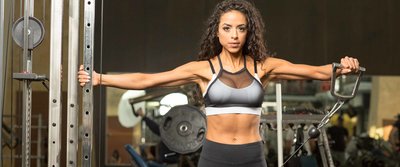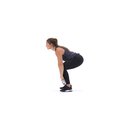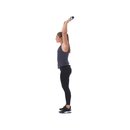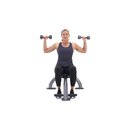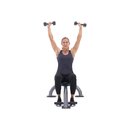Shoulders | Back | Arms | Chest | Legs | Abs & Calves | Final
Introduction
Women who weight train understand the importance of equally developing all the muscles of the body. This ensures the best health, strength, and physique gains possible. The shoulders are a prime example of this concept. Having nicely developed deltoid muscles gives a woman the strength needed to perform every day tasks, balances her symmetry by widening the upper body and minimizing the appearance of the hips, and gives her a statuesque appearance and great posture.
While the shoulder is considered one muscle, it consists of three sections called "heads." They are the anterior (front) deltoid, lateral (side) deltoid, and posterior (rear) deltoid. The function of the front deltoid is to move the arm upward and rotate inward. The side deltoid is responsible for moving the arm outward (abduction). The rear deltoid allows the arm to rotate outward and move backward. These "heads" can be worked together through compound shoulder movements, or separately through movements that isolate a particular head.
This article will teach you how to incorporate a training workout for shoulders into your current exercise program. It will focus on targeting all three deltoid heads for complete shoulder development. The article will also cover new exercises to prevent plateaus, how to train at home on limited equipment, how to train safely to add size to your shoulders, how to develop symmetry of the deltoid heads and with the rest of the body, prioritization, and isolation techniques.
Training Basics
Like any well-rounded workout, your shoulder routine should incorporate exercises to target every muscle in that particular group with a variety of compound (multi-joint) and isolation (single-joint) movements. Let's take a look at the different exercises available to target the shoulder muscles.
Compound Movements
The most common compound shoulder exercises are pressing movements. Generally, all pressing movements are performed in the same manner: Begin with the weight at shoulder height, palms facing forward. Press the weight overhead by fully extending the arms until they are nearly locked out. Reverse the movement back down to shoulder height and repeat for reps.
Pressing movements involve all three deltoid heads to some degree, so they are excellent movements for developing the entire shoulder. Presses also allow you to lift a heavier weight since multiple joints are involved in the lift. This is great for adding size and strength to your shoulder muscles.
- Military Press
- Barbell Press
- Behind The Neck Press
- Dumbbell Press
- Arnold Press
- Push Press
- Clean and Press
Isolation Movements
Note: Not all exercise pictures are exactly as mentioned. The general movement is the same, with the only variance being the type of machine/equipment used.
By "isolating" the targeted muscle, these exercises allow you to separately train the specified muscle, which is great for balancing strength and size and improving symmetry. Most deltoid isolation movements are some form of a raise. They involve lifting the weight from a hang to shoulder height (or a little above) while keeping the wrists and elbows stationary. Reverse the movement and repeat for reps.
Because only one joint is moving during these exercises and each deltoid is a small muscle, you cannot lift a heavy amount of weight without compromising form.
Front Deltoids
- Dumbbell Front Raises—variations: Standing, seated, bent-over
- Cable Front Raises
- Barbell Front Raises—variations: Standing, bent-over
- Lying Incline Front Raise
Side Deltoids
- Lateral Raises—variations: Standing, seated
- Cross-Cable Lateral Raises
- One Arm Lateral Raises—variations: Standing, seated, lying
- Reverse Side Lateral
Rear Deltoids
- Bent-Over Lateral Raises—variations: Standing, seated, lying
- Cross-Cable Bent-Over Lateral Raises
- One Arm Bent-Over Lateral Raises—variations: Standing, seated, lying
- Reverse Flyes (Pec Deck Machine)
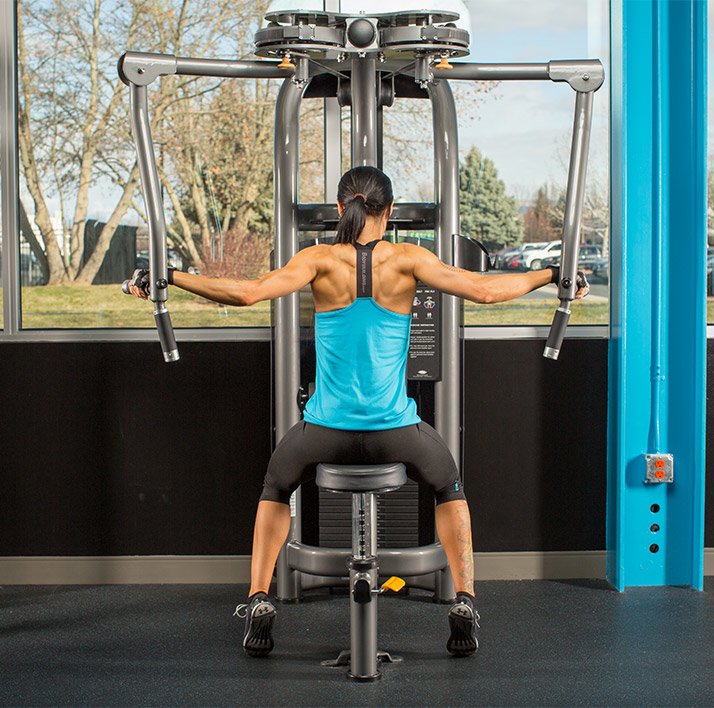
Synergistic Movements
In addition to exercises that directly target the deltoids, there are many exercises where the shoulders play a synergistic role. A synergist is simply a muscle that assists the primary target muscle in accomplishing the lift. Incorporate these exercises into your chest and back workouts to get even more deltoid stimulation.
Front Deltoids
- Incline Bench Press (Chest)
- Flat Bench Press (Chest)
- Decline Bench Press (Chest)
- Regular Push-Up (Chest)
- Incline Push-Up (Chest)
- Decline Push-Up (Chest)
- Chest Dip (Chest)
Rear Deltoids
- Bent-Over Barbell Row (Back)
- Cable Row (Back)
- Dumbbell Row (Back)
Developing Your Training Program
A general, well-rounded shoulder routine should consist of at least two types of compound pressing movements and isolation movements for at least two of the three deltoid heads, alternating between the three heads every workout.
Here is an example of this type of workout
- Seated Dumbbell Shoulder Press (Compound)
- Barbell Press (Compound)
- Lateral Raises (Isolation - Side Deltoids)
- One-Arm Bent-Over Lateral Raises (Isolation: Rear Deltoids)
- Barbell Front Raises (Isolation: Front Deltoids)
Sets & Repetitions
Generally speaking, most people benefit from performing 10-15 repetitions and 2-3 working sets of a particular exercise. This will differ based on your training history, current fitness level, and goals. Women focusing on maintenance should stick to 2-3 sets of 12-15 repetitions. Individuals aiming for mass gains should perform 3-4 sets of 8-12 repetitions. In order to gain strength, you should perform 3-4 sets of 6-10 repetitions.
You can incorporate one, two, or all three rep ranges into your program for variety. For example, women looking to gain size and strength would do well to alternate between the 8-12 and 6-10 rep ranges every other workout.
Additional Muscles Often Trained With Shoulders
You may also wish to add training exercises for your rhomboids, rotator cuff, and trapezius muscles in this program as well. These muscles are often targeted during shoulders training, so it is sensible to pair them with these muscle groups in the same workout.
Frequency, Duration & Intensity
One of the best styles of training is the split training technique, where each body part is worked once a week on its own day, or paired with 1-2 other muscle groups. This allows you to fully tax the muscle to stimulate new growth. If shoulders are a weak body part for you, you may wish to prioritize them by training them twice per week. We will cover prioritization later in this article.
Your training sessions should not last more than one hour. This is plenty of time to fully exhaust the targeted body part. If your workouts are lasting longer than this, you need to stop being so chatty at the gym—you are there to train, not make friends!
You may have the perfect training program and the perfect diet, but you will not see results unless you are training with INTENSITY! This is all well and good, but how do you go about measuring your intensity? The answer to this is individual.
You know in your mind if you could've pushed out another rep or two, or if at the end of your workout your muscles feel like they're only warmed up, rather than shaking, ready to collapse, and begging for mercy. The level of intensity you train at is entirely up to you. You can minimize your rest, take every set to complete failure, implement supersets, drop sets, and negatives, but you have to pull every ounce of energy out of your body and into each rep of each set and every exercise.
If you can do this, only then can you say you're training TO THE MAX!
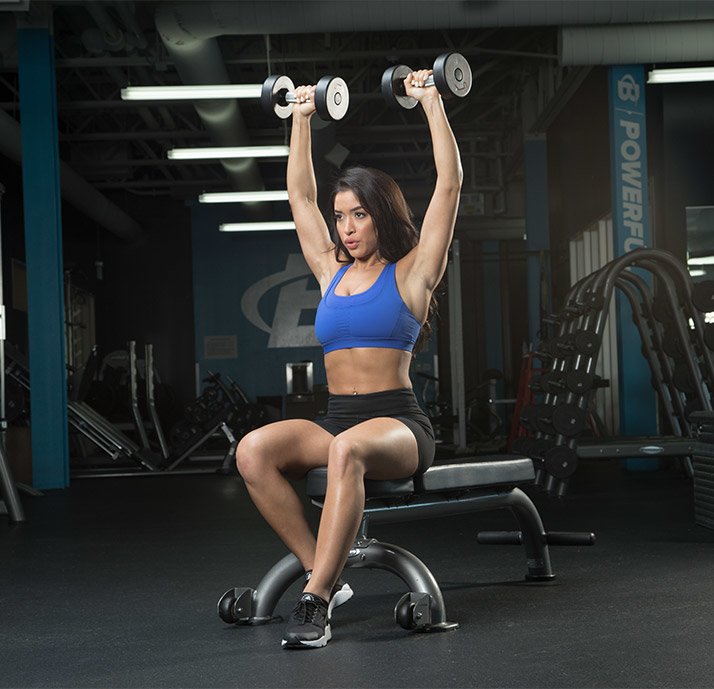
Targeting Specific Goals
Adding Mass Safely
The shoulder muscles are one of the most difficult groups to add size and width to. It is easy to cheat in most isolation movements, especially when trainees have the desire to increase poundage in their eagerness to see new gains. This does nothing except compromises form and takes the focus off the targeted muscle.
One of the best ways that I've found to add shoulder size is to incorporate explosive, powerful movements in some workouts, and supplement those workouts with isolation movements done with strict form and high intensity. Two great power movements for shoulders are push presses and clean and presses.
Push presses are a cheating exercise. I know you've probably been told to never cheat on your form, but there are exceptions to everything in bodybuilding, and this is one of them. That's right, cheating is good, but only at the right time, and push presses are a prime example of this. Push presses involve performing an overhead barbell press by slightly bending the knees on the eccentric, then exploding to a full standing position while simultaneously extending the arms overhead into the fully extended position. Push presses allow two things to happen: they allow you to lift more weight than you can with barbell presses alone, and they allow you to fully exhaust the muscle once it's already reached failure.
Clean and presses are an exercise that begins by "cleaning" a weight - a technique used to bring the weight from the floor to shoulder height - then pressing the weight overhead as in a barbell press. This exercise allows you to lift more weight than in a press alone. It also recruits many additional muscles into the exercise during the cleaning movement, which builds sheer power and strength!
Both the push press and the clean and press are excellent exercises for developing speed, strength, size, and power.
The only reservation you may have to performing these exercises is not knowing how to do them properly. I recommend enlisting the help of a competitive power lifter or advanced personal trainer to ensure you are implementing correct form. The first few times you perform these exercises, use no additional weight until your form is perfected. Then, you can slowly begin adding weight week by week until you are fully comfortable with the exercises.
Other great ways to focus on gaining mass are ensuring you are training at your max intensity. Also make sure you're lifting as heavy as you can, taking the last 2-3 sets to ultimate failure, meaning you can't perform another repetition of the exercise without compromising form.
Perform four working sets in the 6-10 rep range to focus your workouts on mass gains. You may also choose to prioritize this body part, which will be discussed later in this article.
Training At Home
Many women train strictly out of their homes, and in their case, most of these recommended exercises can't be performed with the limited equipment they have at home.
If you can afford it, I recommend purchasing a flat bench, 3-4 sets of dumbbells, and a 45-pound Olympic barbell. More affordable substitutions include an exercise ball instead of a bench, resistance bands instead of dumbbells, and a body bar instead of a barbell. You may use a lot of common household items to train with, also. A chair or short stool can be used for seated exercises, and milk jugs filled with water can be used as dumbbells (similar to kettlebells).
Bear in mind that the quality of equipment used effects the quality of your workouts; an investment in good equipment is an investment in your health and your future.
Exercise Variety
The exercises listed above can be alternated every other workout, every few weeks, or every few months, depending on how often you wish to change them. While the basic shoulder movements seem limited, you only need to be creative to change up an exercise, and your entire routine. Standing front dumbbell raises can be substituted with barbell raises or lying incline dumbbell raises, for instance.
Use the above list to include variety in your program. This not only prevents boredom, it encourages adherence and ensures your body is constantly being challenged to stimulate new gains.
Symmetry
Simply training your shoulders with a variety of exercises at a high intensity is not the only ingredient in developing a well-balanced physique. The ultimate goal of intermediate and advanced trainees is to develop complete body symmetry, or the balance of muscles in size and development between the upper and lower body and the left and right sides of the body, as well as each muscle group in proportion to one another. Good shoulder symmetry includes developing all three deltoid heads equally, and developing the left and right shoulders equally.
If your aim is to bring up a particular deltoid head to equal the development of the others, you can add extra sets and/or an extra exercise in your routine to focus on that deltoid head. An example of this would be to perform four sets of side lateral raises at the beginning of your workout and at the end of your workout to bring out your shoulder width and roundness.
In addition, you can opt to train that head in one of your other workouts where the muscle works synergistically. An example of this would be to add bent-over lateral raises immediately after doing barbell rows on your back training day. This would put extra focus on the rear deltoids, in addition to the separate training they receive on shoulder day. If you wish to bring up the size of one shoulder in relation to the other, you can choose to perform 3-4 additional reps on that side and/or perform additional sets of an exercise on that side.
The final area of symmetry is in relation to the rest of the body. Your shoulders should be bigger in size than your arms, so that the delts taper down to the arms, and the arms taper down to the forearms. (Think the opposite of Popeye!) When you flex your shoulders as in a front relaxed pose or front lat spread, they should remain round, wide and high in appearance (as high as your traps). It's almost impossible to grow your shoulders too big. The bigger they look, the better!
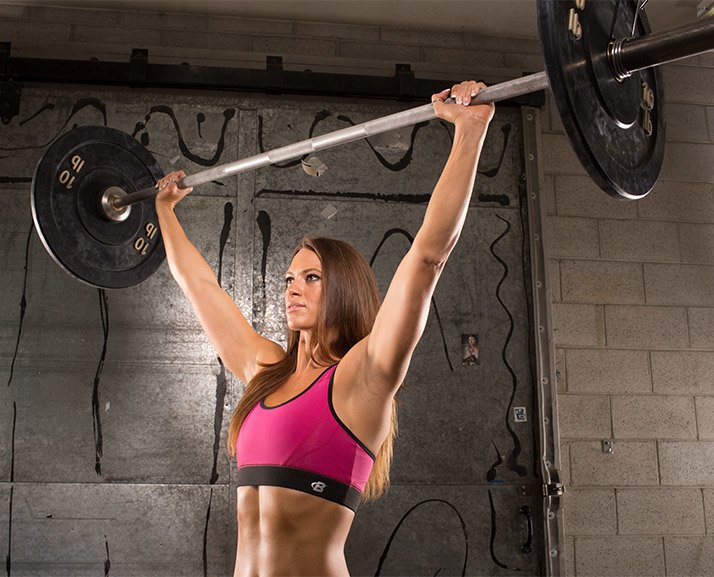
Isolation
Many women have trouble isolating their shoulder muscles during training. The arms and the traps tend to get overly involved, making it frustrating, difficult to make gains, and easy to give up on your training program. The longer you've been training, the easier it is to isolate a particular muscle group. You must learn to "feel" the muscle working and focus all the movement to that particular muscle group. There is a good way to go about doing this.
When performing lateral raises, Ronnie Coleman recommends envisioning the side deltoid muscles pushing upward, rather than using the hands and/or arms to lead the movement. Visualizing the targeted muscle working and leading the movement is the best way to isolate that muscle group during an exercise. Concentrate on visually feeling the muscle and leading the movement in every exercise, and before you know it, it will become second nature.
Another important point is to make sure you don't lock out your elbows during pressing movements. Locking the elbows at the top of the exercise involves the triceps and takes some of the strain off the shoulders, which is what you don't want to do.
Take special care in your form to ensure your elbows are still slightly bent at the height of the movement. You should feel a difference in the targeted muscles immediately.
Keeping your form in these exercises is extremely important, particularly in isolation movements. Since these exercises involve small muscles, the amount of weight is limited, but when we train we still tend to gravitate towards increasing poundage at every workout. This is useless if your form is being compromised. Rather than going up in strength, you're just cheating to lift a heavier weight. Make sure you remain perfectly still except for the primary mover in the exercise.
It's easy to shrug the shoulders in an effort to lift the weight once the muscles start to fatigue, but this puts more strain on the trapezius muscles and takes the focus off the deltoids. Keep the elbows locked in a slightly bent position, and ensure the wrists stay locked in place for the duration of the movement. Your shoulder joint should be the only one moving during all isolation movements.
Prioritization
There are several techniques used to prioritize a body part. Two of my favorite techniques include training shoulders twice a week (once heavy and once light) and training shoulders every other week with power lifting movements.
The best way to implement the twice a week concept is to train shoulders at max weight and intensity on day one of your training week. This is when you are well rested and ready to start the new week with a bang! You will have the most energy and in most cases, quite a bit of motivation, early on in your training week.
Perform your other workouts as normal on the days you've designated for training them, then take a rest day before training shoulders again lightly, perhaps varying the exercises or adding in exercises for a particular deltoid head in this workout. Make sure there are at least two days of rest between both shoulder workouts.
The power lifting/bodybuilding technique is a more advanced and more effective way to train the shoulders for size and strength. This concept gives you a full week to rest after heavy weight training before again hitting up this muscle group. The twice a week concept is actually a derivative of this type of training. Think of this program as a two-week cycle.
Week one will be comprised of 2-3 heavy, core movements in the 4-8 rep range. This will stimulate your muscles for ultimate strength gains. Week two will consist of a more traditional bodybuilding style workout. Focus this week on higher intensity, but keep the reps in the 8-12 range and perform 4-5 total exercises.
Go Heavy, Go Hard
Many women are scared to lift heavy because they think they'll "bulk up" or "look like a man." In reality, this couldn't be further from the truth! Women who use the words "tone" and "firm" have been misinformed. These words are simply more acceptable than the terms "mass" and "size," while they mean the same thing! There are only two ways to change your body through training ? gaining muscle, and losing fat. That's it.
So, don't be afraid to lift heavy. You will gain muscle slowly as a woman, and you definitely won't wake up huge after one training session! Lift as heavy as you can until you've reached the amount of size and development you want, then taper off the weights slightly to maintain what you've worked so hard for without compromising any of your shapely muscles.
Sample Shoulder Training Program
This program will focus on three goals: Overall shoulder development, Ultimate Intensity for strength and size, and Variety to prevent boredom and to ensure constant stimulation. This program alternates one week of heavy movements with a second week of more intense movements, to stimulate your muscles for maximum strength and size gains.

BodyFit
$6.99/month- 2,500+ expert-created single workouts
- 3,500+ how-to exercise videos
- Detailed workout instruction
- Step-by-step workout tips
- Training at gym or at home
- Access to Workout Plans
- Access to Bodyfit App
- Store Discounts
Already have a Bodybuilding.com account with BodyFit? Sign In

What comes with BodyFit?

- Instructional Videos
Don't risk doing a workout improperly! Avoid injury and keep your form in check with in-depth instructional videos.

- How-to Images
View our enormous library of workout photos and see exactly how each exercise should be done before you give it a shot.

- Step-by-Step Instructions
Quickly read through our step-by-step directions to ensure you're doing each workout correctly the first time, every time.

BodyFit
$6.99/month- 2,500+ expert-created single workouts
- 3,500+ how-to exercise videos
- Detailed workout instruction
- Step-by-step workout tips
- Training at gym or at home
- Access to Workout Plans
- Access to Bodyfit App
- Store Discounts
Already have a Bodybuilding.com account with BodyFit? Sign In

What comes with BodyFit?

- Instructional Videos
Don't risk doing a workout improperly! Avoid injury and keep your form in check with in-depth instructional videos.

- How-to Images
View our enormous library of workout photos and see exactly how each exercise should be done before you give it a shot.

- Step-by-Step Instructions
Quickly read through our step-by-step directions to ensure you're doing each workout correctly the first time, every time.


